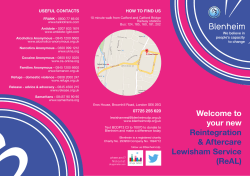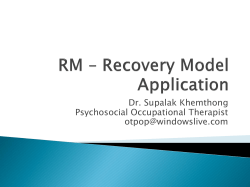
Document
Best Practices in Reintegration & Religious Rehabilitation Muhammad Saiful Alam Shah issaifulalam@ntu.edu.sg Outline 1. Reintegration The importance Present model Challenges 2. Religious Rehabilitation The importance Present model Challenges Page 2 of 11 Reintegration – The importance • Positive outlook • Conducive environment to promote change Page 3 of 11 Reintegration – Singapore Support during period of detention • Provide detainees’ families with financial, emotional & social support • A case worker is assigned to each family • Facilitate in the reintegration process of the detainees released under Restriction Orders (RO) ACG Postrelease support • Provide financial assistance and counseling to families until they are able to cope Page 4 of 11 Reintegration – United States Infrastructure Family REINTEGRATION Religious community State-Church relationship Source: Mr. Joe Pryor, former U.S. Bureau of Prisons Page 5 of 11 Reintegration – Belgium • • • • Continuous education Work-study job Family’s welfare Readily available institution Source: Ms. Jessika Soors, Project Coordinator, Radicalization and Polarization, City of Vilvoorde, Belgium Page 6 of 11 Reintegration – Challenges • State policy • Civil society’s role • Confidentiality Page 7 of 11 Religious Rehabilitation – The Importance • Confrontation (and challenging) of radical ideology • Disengagement from violence & radical ideology • Reintegration into society Page 8 of 11 Religious Rehabilitation – Present Model Page 9 of 11 Religious Rehabilitation – Challenges • • • • Defining religious authority New ideologies Indigenous programme Network of scholars Page 10 of 11 Thank you Page 11 of 11
© Copyright 2025










